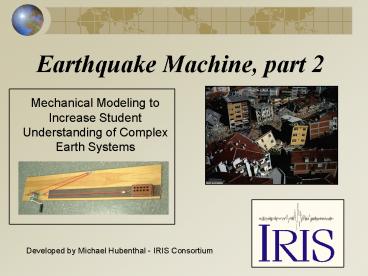Earthquake Machine, part 2 - PowerPoint PPT Presentation
Title:
Earthquake Machine, part 2
Description:
Seismic Moment Mo = fault ... of seismic moment where constants in the equation have been chosen so the moment magnitude scale correlates with other magnitude scales. – PowerPoint PPT presentation
Number of Views:123
Avg rating:3.0/5.0
Title: Earthquake Machine, part 2
1
Earthquake Machine, part 2
Mechanical Modeling to Increase Student
Understanding of Complex Earth Systems
Developed by Michael Hubenthal - IRIS Consortium
2
Objectives
- Describe global trends for Earthquake occurrence
and magnitude - Interpret a Gutenberg Richter plot (Frequency vs.
Magnitude) - Critically analyze an argument
- Describe the importance of sharing science
results with peers in the science process
3
Studying Earthquake Recurrence
3
4
Developing arguments.
How many beads are in the box????
5
Relationship of slip to magnitude
Seismic Moment Mo fault length x fault width
x displacement x rigidity
Moment Magnitude Mw log Mo/1.5 10.7
6
Visualizing magnitude with the model
Seismic Moment Mo fault length x fault width x
displacement x rigidity
Moment Magnitude Mw log Mo/1.5 10.7 In
earthquake machine, this means magnitude is
directly related to fault displacement
6
7
(No Transcript)
8
1
- There are long periods of quiet
- between earthquakes
Most earthquakes are huge, deadly and
destructive events
2
There hasnt been an earthquake in a long time
therefore the next one must be huge.
Extra credit
Develop an argument either for or against one
statement based on your experimentation with the
earthquake machine.
9
There are always long periods between
earthquakes.
10
All earthquakes are huge, deadly, and
destructive events
11
(No Transcript)
12
Time Predictable
Slip Predictable
Characteristic
Stress
Slip
Time
13
Calaveras Fault Data
(Bufe et al., 1977)
14
(No Transcript)
15
Seismicity of the EQ Machine - 67 Years
16
Seismicity of the EQ Machine - 163 Years
17
Summary
- There are many more small earthquakes than large
earthquakes - There are more short time periods between
earthquakes than long time periods - In the earthquake machine, the longer since the
last earthquake, the larger the earthquake is
likely to be - This isnt usually true in the Earth































